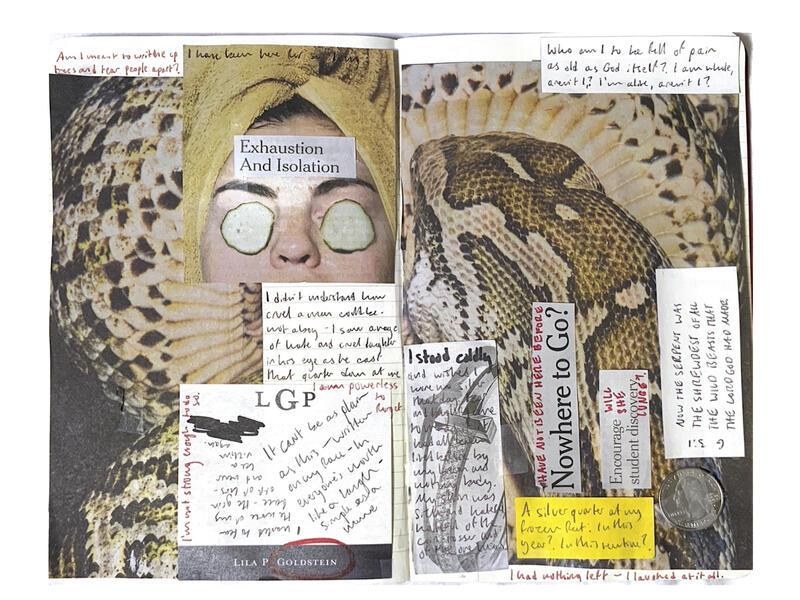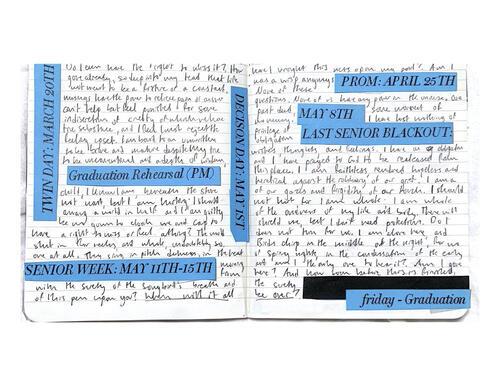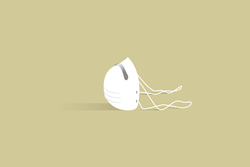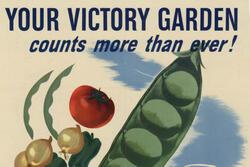Collaging in Quarantine
Like many of the millions of Americans sheltering in place these days, I try to stay grounded through routine. Every day I wake up, attend online classes or programs, try and take a walk, and, most importantly, make collage art. I grab whatever paper products I can find around (college brochures and lifestyle magazines are common), sit at my desk, and get to work cutting, arranging, and taping the colorful pieces together. Collaging is an old hobby of mine that has taken on new value during this pandemic; it started off as a casual way to keep my hands busy and repurpose some of the reading materials around my house. Now, I find that this art has become a significant part of my life, a visual representation of my experiences, thoughts, and interactions with the world.
I made my first collage a few years ago after seeing artists make them on social media. While I’d never had much interest in creating visual art before, I felt strongly about the media I consumed on a daily basis and wanted to express the same creativity I could in writing with preexisting images and text. Armed with zero technical skill and a house’s worth of old newspapers and magazines, I began to collage. I hoped, in my first few pieces, to express something completely unique to myself, with symbolism that existed to remind me of personal events and memories.
There is inherent power, I have learned, in creating something purely for oneself, without any need to impress or impact an audience. My creations are filled with visual associations that take their meaning through my point of view. My sloppy cutting and hastily applied tape affirm the fact that I have no deadlines, no rules to follow, and no limit to what I can paste into my notebook.
For a while, the freedom and creativity of collage provided much needed relief from the precise, grammatical art of writing. In spite of this initial opinion, I began to integrate lines of my own written text in the midst of my images, allowing me to add commentary and customize my artwork further. As I dug through stacks of magazines and old mail for inspiration, I found myself moved to create something that commented on my Jewish life, both the positive and negative experiences.
This art has allowed me to express all aspects of my personality, including my Jewish identity. Through some casual research, I have come across contemporary collage artists who also use their artistic skills to reflect their relationship with religion and the past. Deb Goldstein is a Massachusetts-based collage artist who takes inspiration from her family and past, using photographs and correspondence to craft her pieces. We both seek to express our history through storytelling, both visual and written, and use collage as a vehicle to do so. Because so much of my identity is nuanced and understood through reflection, Jewishness can sometimes feel like a passive aspect of my life, one that exists only in distinctly Jewish spaces or in the memories of the past. By expressing my personal experiences with Judaism though tangible pictures and words, I can bring my identity to the forefront of my everyday life.
During this pandemic specifically, I have begun to embrace collage as a type of art therapy. When I take the physical news in my hands, I have the ability to make the unbelievable accessible, cutting up paragraphs and headlines and repurposing them to reflect the personal nuances of every story. I also have the ability to add to and even rewrite the articles themselves, filling in my own poems and thoughts in the spaces between paper cut-outs. I’ve used school fliers, replete with dates of events that never were held, to fill up the pages before me, hoping to process the disappointment of a senior year cut short. I write on sticky notes and mark up the pages with red pen, turning my collage notebook into a reminder of in-person schooling and note taking. Spending all of my days at home for the first time in my life, I have had the time and space to process the transition to distance learning and isolation.
Collage has allowed me to process visual culture by allowing me to reflect life’s chaotic and confusing moments. In times like this, it feels only natural to tear apart reminders from a different world, and rearrange them to fit my current life. In the pages of my book I can see receipts, letters, photos, study guides, and more, and know that they take on a deeper meaning when positioned with care and accompanied by stories and memories.
I’ve also been able to take a deeper look at what it means to hold Jewish identity, especially during a period of social isolation, through collage. Looking at the artwork of Deb Goldstein and others, I think that Jewish thought lends itself to collage; our community is full of overlapping voices and unique perspectives that are united in the pursuit of understanding one another.
My identity is an amalgamation of different inspirations and experiences. It is equally both difficult to unravel and rich in detail. When I sit down in the afternoons with my papers, scissors, and pens, I very rarely have preset plans on what I will make. My designs vary in tone and style, mirroring my own daily changes as I grapple with life during a pandemic as a graduated high school senior. Nevertheless, I am comforted by the fact that I have the right to make art that is uncomfortable, angry, strange, and even meaningless, as long as I have the will to do so.
This piece was written as part of JWA’s Rising Voices Fellowship.







